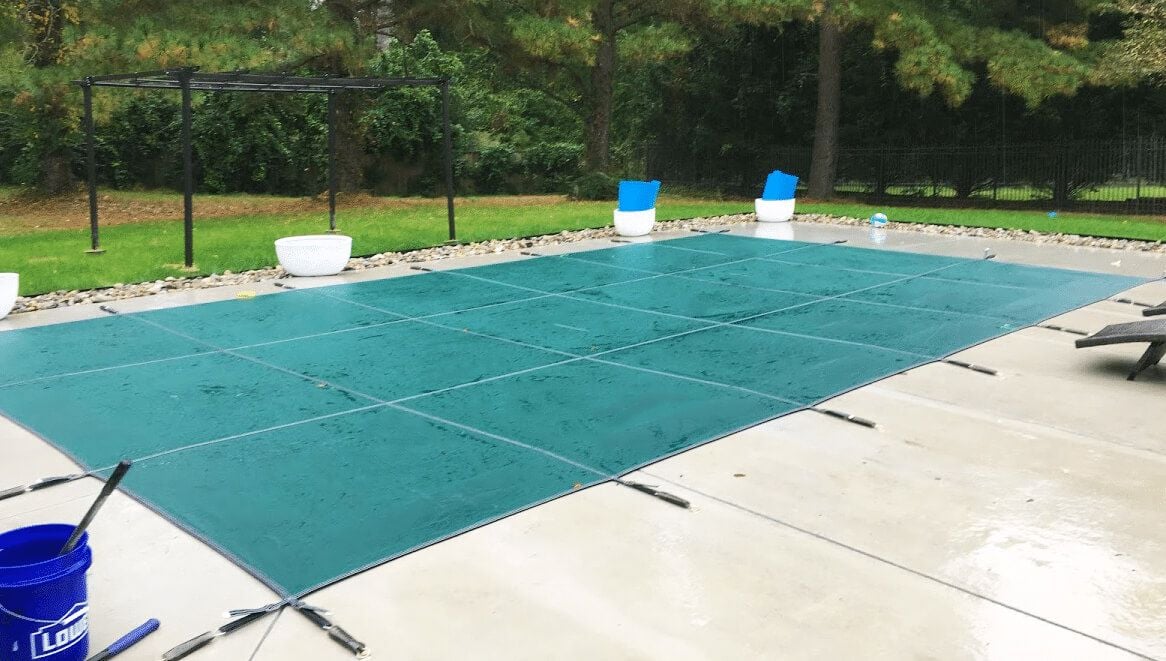
How to Buy a Pool Cover: Sizing, Types, Prices
As we take our last dips in the pool and start deflating our giant pizza slices and rainbow unicorn floats, we are reminded that all good things must come to an end.
At least until next summer.
Within a few weeks, it will be time to close up your sparkling oasis and say goodbye for the winter.
And if you don’t want your pool to become a swampy mess until then, you might want to consider adding a pool cover.
After 20 years of servicing, building, and now manufacturing fiberglass pools, we’ve witnessed the benefits of keeping a pool cover on an inground pool during the offseason (fewer leaves, less dirt, etc.).
The outcome might vary depending on the type of cover you have, but generally, having a pool cover should make your life a bit easier come springtime. In this article, we’ll break down the different types of pool covers that you can buy, where to buy them, and how to choose the right pool cover size.
By the end, you should know where to buy a pool cover, which type you might want to buy, and which approximate size you’ll need to order.
Let’s dive in.
Inground Pool Cover Types
There are three main swimming pool cover types. These include:
- Winter
- Security
- Automatic
Other pool covers, like solar covers, are less often used to secure the pool during the winter months. Custom-built covers, like rolling deck pool covers, are much more expensive. For these reasons, most people will choose between a winter, security, or automatic pool cover for their swimming pool during the offseason.
Where to Buy a Pool Cover
When the fall finally rolls around, it’s not uncommon for people to ask us, “Where can I buy a pool cover?”
Most pool covers can be purchased from pool supply shops or major retailers like Amazon. You might need to locate a dealer if you want to get an automatic pool cover, but you should be able to buy a winter or safety cover without going through a dealer or salesman.
How to Measure a Pool for a Cover
If you’re wondering how big your pool cover needs to be, you can measure your inground pool to determine the right cover size before you go out and buy one, or you can use your pool’s dimensions if it’s a linear shape. Not sure if you have the right dimensions? Here’s how to measure for a pool cover:
- Using a measuring tape, measure the length and width of your pool on all sides.
- Be sure to include protruding steps and any other part of your pool that might extend outside the main area.
- Measure in feet.
For example, our L36 pool is linear in shape, but it has two curved sections on each end. Both of those need to be included while measuring your pool to get the right size pool cover.
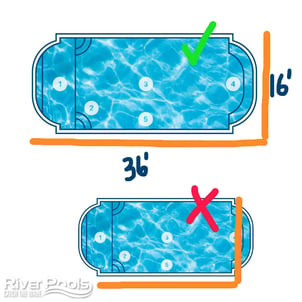
Rectangular pools and simple geometric or freeform shapes are the easiest to measure, but if your pool is irregularly shaped, you might need to order a custom pool cover.
Your pool cover manufacturer should provide exact instructions for measuring your inground pool for a custom cover, which will likely call for a more complex measuring method known as A-B measuring. Here's a brief breakdown of what that might entail.
How to Measure Your Pool for a Custom Pool Cover
Establish two points (A and B) about five feet away from the edge of your pool. Points A and B should be at least half the length of your pool apart from each other and should not cut across your pool at any point.
In our example, the I30s is 30 feet long, so the distance between point A and point B needs to be at least 15 feet.
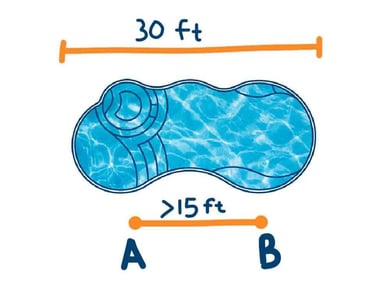
Next, you’ll need to mark some new points around your pool and then measure the distance between points A and B and the new points. Begin by marking point #1 at the inside edge of the pool's coping halfway between points A and B. Then, continue marking new points on the coping all the way around your pool until you get back to where you started. The points should be about two to three feet apart. You can label your new points numerically for the sake of clarity.
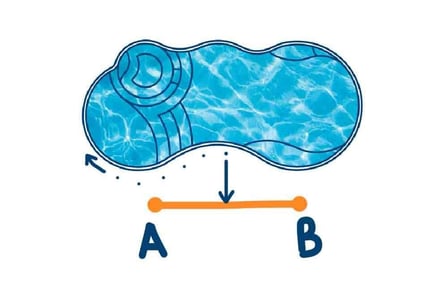
Once you have done that, you’ll be ready to start measuring the distance between points A and B and all of the smaller points marked around the pool’s edge.
To measure your pool, start with point A and measure the distance between point A and each numerical point. Then, go back and measure the distance from point B to each of the numerical points around your pool. You can label the measurements as A1, A2, A3, B1, B2, B3, and so on.
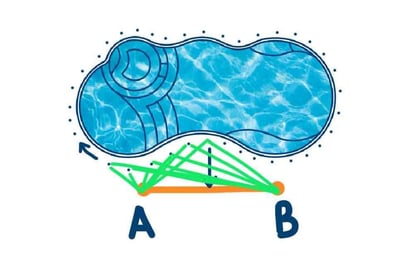
Note: You’ll need all of your measurements when ordering a custom pool cover, so be sure to write them down. You may also need to take pictures of your pool as a reference or draw a diagram of your pool with the different points, depending on your pool cover manufacturer's instructions.
Pool Measuring Tips
- Most pool covers come slightly larger than the pool size, so you won’t typically need to factor in extra space when placing your order.
- If you’re stuck between two sizes, order a size up rather than a size down.
- When in doubt, measure again.
- For custom pool covers, carefully follow any directions that your pool cover manufacturer provides.
And then there's the easy way...
The easiest way to measure your pool for a pool cover is to have someone do it for you. You can always go to your local pool supplier and hire them to measure and install the cover for the first time. This is especially a good idea if you're interested in buying a spring loaded safety cover.
Pool Cover Prices
If you’re wondering how much your inground pool cover might cost, you can expect to pay anywhere from $75 to $22,000. Winter pool covers using tarp-like materials tend to be cheaper, while mesh and solid covers typically cost more at $1,200 to $3,000. Automatic pool covers cost the most at $12,000 to $22,000.
- Winter pool cover: $75 - $225
- Security pool cover: $1,200 - $3,000
- Automatic pool cover: $12,000 - $22,000
Read more: How Much Do Inground Pool Covers Cost?
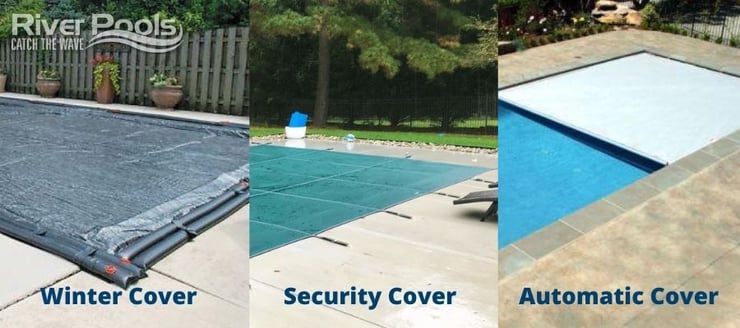
When to Add Your Pool Cover
Unless you’re incorporating hidden tracks under your pool coping for an automatic pool cover or adding in a custom sliding deck, you can add a cover to your pool at any time of the year after the pool's installation.
If you’re planning to close your pool soon, it might be a good idea to install the cover when you close the pool down for the year to keep it as clean as possible until spring.
Are you ready to add a cover to your inground pool? You can explore your pool cover options in more detail by reading the articles below:
Swimming Pool Covers: The Good, the Bad, and the Ugly
Automatic Pool Covers Pros and Cons
Solid Vinyl vs. Mesh Inground Winter Pool Covers: Which is Better?
At River Pools, we manufacture high-quality fiberglass swimming pools for customers across North America. If you're interested in getting a fiberglass pool for your home, you can browse our pool models, try out our pool pricing calculator for a fast estimate, or request a custom fiberglass pool quote using the button below. Happy swimming!
Up Next:
Automatic Pool Cover Winter Maintenance: Everything You Should Know





